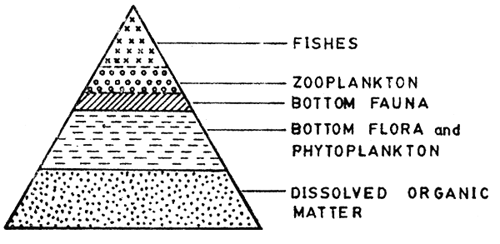The transfer of food energy from the plants through a series of organisms is referred to as the “food chain”. Since it is not a single chain, but often interlinking of energy transfer through several chains as a net or web, the food chain should be more precisely referred to as food web. At each transfer a large proportion of the potential energy in the food is lost as heat. The number of steps or links in the transfer sequence is usually limited to 4 or 5. The shorter the food chain (or the nearer the organism to the original food source) the greater the availability of energy which can be converted into “biomass”. For this reason aquaculturists can produce fish more efficiently if they culture herbivorous fish.
Three types of food chains are often recognized in water bodies as on land (i) the predator chain start from a plant base through small animals to larger animals; (ii) the parasite chain, from larger to smaller organisms and (iii) the saprophytic chain, from dead matter into micro-organisms.
In communities organisms whose food is obtained from plants (phytoplankton) by the same number of steps are said to be at the same trophic level. Thus the plants occupy the first trophic level and plant (and phytoplankton) eaters, the second trophic level, carnivores, the fourth trophic level (see autotrophs and heterotrophs under ecosystem). A species in an ecosystem can occupy more than one trophic level according to the sources of energy assimilated, e.g. many fishes change their food depending on the availability even though they may have specific food preferences. The separation of trophic levels and relative abundance of various components in the standing crop (biomass) or aquatic organisms can also be known by determining the mass of each group of organisms (even beginning with the more basic abiotic component - the dissolved organic matter). Such a study done earlier showed that in a lake of about 60% of the total weight, could be represented by dissolved organic matter, 0.5% by fish and 5% by other animals. This can be clearly shown graphically by a pyramid of ‘Biomas’ (Fig. 10.1).
This concept can be entended to the fish pond as well, and inventory of the fish pond flora and fauna and their relative masses (standing crops) and numbers could give the aquaculturists considerable information on the production potential and maintainance of fish pond (Tang, 1970).
The energy flow through a trophic level is the total energy assimilated at that level which is utilised for biomass production and respiration (energy dissipated) at that level. Energy flow in an ecosystem follows the laws of thermodynamics. Energy inflow at any trophic level balances outflow at that level as required by the first law and energy transfer at each trophic level is accompanied by the dispersion of energy into an unavailable form (dispersed heat - respiration) as required by the second law of thermodynamics. A fact of much interest in the aquaculturist, as referred to is that, at each trophic level considerable amount of potential energy is lost and therefore cultured of fishes at the higher trophic levels become less economical (energy-wise) due to the ‘sieving and concentrating’ of successively lesser and lesser available energy (see Fig. 10.2).

Fig. 10.1. Weight Relationship of Components of Biota and Dissolved Organic Matter in a Lake (After Welsh, 1957)
Ecological efficiency or the efficiency of conversion of energy from one trophic level to the next is very low, only 1% of the usable radiant energy of the sun is absorbed by chlorophyll in plants. The total efficiency of the ocean in solar energy fixation is 0.18% i.e. of the radiation reaching sea surface, but in shallow water, this efficiency is much higher.
The efficiency of energy transfer at various trophic levels studied in an aquatic ecosystem is indicated below: given in Odum, 1957)
Phlosynthentic plant (primary producers) - 1 - 2%
Herbivores (primary consumers) - 16%
Small carnivores (secondary consumers) - 11%
Large carnivores (tertiary consumers) - 6%
Thus it is evident that a large portion of solar energy absorbed by the plant is dissipated as heat (efficiensy is less than 10% often) and at the higher trophic levels the efficiency is better, and perhaps is about 10% on average.